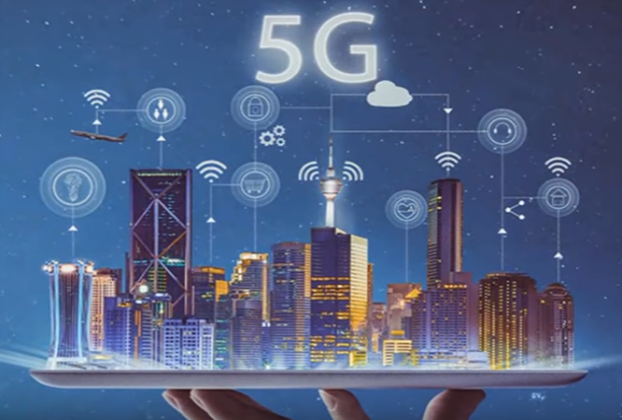Mobile data traffic is speculated to exceed traffic from wired devices in the next couple of years. This emerging phenomenon will be empowered by revolutionary 5G radio network technology with a focus on application-driven connectivity. 5G, or fifth-generation technology, is the next generation of wireless network technology.
Over the past 35 years each G or Generation introduced to us a new thing that we could transmit with our phones. 1G was analog cellular which gave us sound, 2G (or E), being the first generation of digital cellular technology provided short text and messaging capabilities, 3G gave us mobile web and 4G LTE made data communication speed about 10 times faster.

The next generation (5G) is expected to arrive around 2020. There are five trends, which are pushing the limits of 4G, compelling the need for a Fifth generation cellular network technology:
Trend 1 – Increase in capacity: The demand for wireless data is predicted to increase significantly, resulting in 1,000 times greater mobile data volumes.
Trend 2 – Phenomenal increase in the number of connected devices: The number of connected devices is predicted to increase by a factor of 10–100, which means that up to 300,000 devices, whether small or big, need to be served per access point.
Trend 3 – Decrease in latency: Remote presence and tactile Internet impose strict latency constraints on the end-to-end connection, including the wireless part. Prediction indicate that the latency should be decreased by a factor of 5 in order to have such services efficient.
Trend 4 – Increase in efficiency: Efficiency in terms of resource utilization (e.g., energy, frequency spectrum) is becoming more and more conspicuous. It is seen as an indispensable ingredient for a healthy/sustainable ICT market and environment.
Trend 5 – Increase in reliability: Wireless connectivity will be applied to new use cases that require extremely reliable connections (typically 99.99% availability) and mission-critical communications, such as vehicle-to-vehicle coordination, critical control of the power distribution grid, etc.
So what’s the big deal with 5G? First of all 5G is super fast. The fastest 4G modem today maxes out at 2 Giga bits per second while 5G’s maximum speed is 10 times that is, 20 gigabits per second and those crazy high speeds are coupled with nearly zero latency rate, which is referred to as the delay between sending and receiving information between devices. 5G is eventually expected to communicate in real-time, with 1 millisecond of lag.
5G is not just faster – Lower latency and more flexibility mean it will start an era of augmented reality, self-driving vehicles, and other applications we haven’t dreamed of yet. Though it’s going to take years to realize 5G’s full potential.
5G will bring about three major things:
1- Super-fast speed: gigabit speeds that far exceed the data demands of today’s common uses,
2- Lower latency: to be more responsive,
3- Ability to connect billions of devices online – expediting the Internet of Things.
5G will help hook up new technologies to the internet. This could mean that medical technologies like remote surgery could take place over 5G networks, or driver-less vehicles could operate connected to the 5G grid, virtual and augmented reality will become more real and factories could use 5G to operate more efficiently with remote robots and all this will pave the way for building smart cities.

5G also will enable smarter, more powerful networks, allowing AI-powered devices to better understand the environment in which they operate and cloud computing systems to run more efficiently on mobile and other smart devices. And the benefits will not be confined to large corporations. The power and promise of 5G combined with cloud, AI and edge computing will transform the ways all of us live, work, travel, play, make social interactions and deliver services. And that means new opportunities for an entirely new ecosystem of entrepreneurs and local systems.
4G provides the average of about 100 to 200 millisecond latency and to be fair 100 millisecond is real fast. But to our surprise 5G would get it down to as low as 1 millisecond. That’s almost real time. So the 100 times faster speed and ultra-low latency will be enough to stream “8K” video or download a 3D movie in 3 seconds. Remember on 4G, it would take six minutes.
Being able to send and receive information essentially in real time means we can use 5G to interact with physical and virtual things in real time. We’ll be able to interact with and control physical and virtual objects and even people. A network of self-driving cars, all sending and receiving data about each other and communicating with traffic lights, road sensors and other digital signals coming in their way. Remember that human reaction speed is 200 millisecond and consequently we observe thousands of accidents every day. Imagine if your car on the road could communicate and interact with hundreds of vehicles around it in just a millisecond, we’ll certainly be able to reduce the car accident rate to a large extent.
Numerous applications in the real life are awaiting 5G technology anxiously. Think of all robotic devices. Surgeries could be performed in one side of the world with robots controlled in real-time by the expert surgeons from other parts of the world, in real time. Imagine well-disciplined, secure traffic which is well-aware of the surroundings and capable to take immediate action in any situation, without losing nerves. Imagine drones flying over field of crops making use of sensors on the ground to sort, feed and water every part of the field. Imagine fast learning by getting involved using virtual presence and augmented reality empowered by 5G. The idea of Internet of Things (IoT) has been around for quite some time, but 5G is committed to make it a reality and go one step further to realize “Internet of Everything” means everything, everywhere will be digitally connected, and responsive to our actions and likings.
Like the predecessor technologies, the return on 5G investments will unravel over time as network carriers kick in to obtain spectrum licenses, purchase and deploy equipment, and start selling new high-speed services. But the bigger economic impact will come from the long-term breakthroughs to which the networks will imminently lead.
Key Features of 5G Technology
Short wavelength communications
5G uses what are called millimeter waves, or short wavelength radio signals. This requires substantially additional bandwidth that is allocated on the frequency spectrum between 30–300 GHz. This increases in the bandwidth will accommodate more data and more connections at a time. This will require shorter wavelengths than previous networks, which offers an inevitable hurdle that they cannot travel longer distances. These signals also cannot easily penetrate through walls and are easily absorbed by moisture in the air.
Small Cell Tower installations
To make sure that signals are able to travel farther without fading, “small cell” towers using a dense deployment will be installed within an area to handle the smooth propagation of the signals. They will be much smaller than today’s typical cellular towers. These small cell towers will be placed within a distance of typically no less than 200 feet and no more than 1,000 feet apart, so they are quite close to each other. The advantage to being smaller is that there is more versatility to where they are required to be installed. They can be put on the side of buildings, apartment roof-tops, utility poles, street corners etc. The small cells then transmit and receive data on the 5G network covering a certain small area in their vicinity. So the idea of 5G is replacing, or in fact complementing, high power, low frequency towers with low power, high frequency small cells that communicate with their respective base stations.

Beamforming Signaling System
Beamforming sends the data from the small cell directly to the user. Since the signal is more concentrated, it reduces interference as well. Like its predecessor 4G, a 5G network makes use of packet switching over an IP network for data delivery.
Full Duplex capabilities on the base station
Today’s wireless providers don’t actually use full-duplex transceivers. In a 5G network, the use of full-duplex will allow data to be transmitted and received on base station transceivers at the same time using the same frequency. Past systems that supported full-duplex communications had to separate frequency channels to allow two users to communicate at the same time without having to take turns for transmitting and receiving. This way, it is possible using just one frequency channel through a circuit design which utilize high speed switching.
Today many nations have already got involved in the rat race by devoting considerable resources to 5G. China is planning to spend $400 billion uptil 2020 on 5G and has already built some 350,000 cell sites to provide the network. South Korean wireless carriers have invested more than $9 billion in 2018 alone, with plans to have a nationwide network deployed by 2020. Japanese companies have pledged more than $45 billion over the next five years. The United Kingdom, Italy, and Spain are all set to hold 5G spectrum auctions for 2019.
US carriers pledge that 5G will be available nationwide by 2020. With Sprint’s expansive 2.5 GHz spectrum, T-Mobile’s 600 MHz spectrum, and other combined, the New T-Mobile plans to create the highest capacity network in U.S. history. But the first 5G networks won’t be too near. 5G isn’t a single technology or standard, but rather a shape of different technologies, and deploying them could require a different approach from the ground up. Carriers have launched pilot programs that demonstrate big leaps in wireless technology performance, but mobile networks based on the “millimeter wave” technology that may deliver the fastest speeds all over, probably won’t be available for years.
Because of the unavailability of the 5G-capable, rich infrastructure achieving real 5G for the major part of the word, if not all, is a perpetual struggle. In the meantime, companies will likely build 5G networks based on other technologies that will be faster and more efficient than today’s networks, but can largely rely on existing infrastructure. Individual companies don’t determine and lay out communications standards. In the case of 5G, it’s a group called Next Generation Mobile Networks (NGMN), an association that brings together the minds of research engineers, hardware manufacturers, mobile service providers and other entities looking to develop this next generation system.
5G will be the cornerstone technology of the next digital revolution. It is expected to bring enormous changes in the fields of telemedicine, precision surgery, physical therapy with AR, and even remote surgery in the near future. Hospitals, will be able to make use of a massive sensor network that will help monitor patient health and conditions. The revolutionary change in everyday life will be evident; connected devices, vehicle-to-vehicle coordination, critical control of the power grid, smart agriculture, Massive Machine Communications (MMC), remote presence, tactile Internet, connected cities and homes…and even more!!




